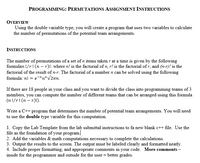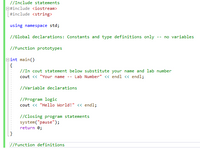
Database System Concepts
7th Edition
ISBN: 9780078022159
Author: Abraham Silberschatz Professor, Henry F. Korth, S. Sudarshan
Publisher: McGraw-Hill Education
expand_more
expand_more
format_list_bulleted
Question
For C++

Transcribed Image Text:**PROGRAMMING: PERMUTATIONS ASSIGNMENT INSTRUCTIONS**
**OVERVIEW**
Using the double variable type, you will create a program that uses two variables to calculate the number of permutations of the potential team arrangements.
**INSTRUCTIONS**
The number of permutations of a set of \( n \) items taken \( r \) at a time is given by the following formula: \( n! / r! (n - r)! \), where \( n! \) is the factorial of \( n \), \( r! \) is the factorial of \( r \), and \( (n-r)! \) is the factorial of the result of \( n-r \). The factorial of a number \( n \) can be solved using the following formula: \( n! = e^{-n} n^n \sqrt{2\pi n} \).
If there are 18 people in your class and you want to divide the class into programming teams of 3 members, you can compute the number of different teams that can be arranged using this formula \( n! / r! (n - r)! \).
Write a C++ program that determines the number of potential team arrangements. You will need to use the double type variable for this computation.
1. Copy the Lab Template from the lab submittal instructions to a new blank C++ file. Use the file as the foundation of your program.
2. Add the variables & math computations necessary to complete the calculations.
3. Output the results to the screen. The output must be labeled clearly and formatted neatly.
4. Include proper formatting, and appropriate comments in your code. *More comments* – inside for the programmer and outside for the user = better grades.

Transcribed Image Text:```cpp
// Include statements
#include <iostream>
#include <string>
using namespace std;
// Global declarations: Constants and type definitions only -- no variables
// Function prototypes
int main()
{
// In cout statement below substitute your name and lab number
cout << "Your name -- Lab Number" << endl << endl;
// Variable declarations
// Program logic
cout << "Hello World!" << endl;
// Closing program statements
system("pause");
return 0;
}
// Function definitions
```
### Explanation
This is a simple C++ program primarily designed for educational purposes. Here's a breakdown of the code structure:
- **Include Statements**: The code starts with the inclusion of necessary libraries `<iostream>` and `<string>`, which are used for input-output operations and string handling, respectively.
- **Namespace**: The `using namespace std;` line allows using standard C++ library members without needing to prefix them with `std::`.
- **Comments**: Throughout the code, comments are included to guide the user on what each section is intended for, such as global declarations, function prototypes, and function definitions.
- **Main Function**: This is where the program execution begins. It contains several sections:
- **Output Personalized Message**: Users are instructed to substitute their name and lab number into the provided `cout` statement.
- **Output "Hello World!"**: A basic output statement, often used as the first program one writes when learning a new programming language.
- **Pause Before Exit**: `system("pause")` halts the execution of the program, waiting for user input before closing the console window. This is useful for keeping the console window open to view output.
- **Program Termination**: The program returns `0` at the end, which signifies successful termination.
This example illustrates basic elements of programming in C++, such as structure, syntax, and simple output operations.
Expert Solution
This question has been solved!
Explore an expertly crafted, step-by-step solution for a thorough understanding of key concepts.
This is a popular solution
Trending nowThis is a popular solution!
Step by stepSolved in 3 steps with 1 images

Knowledge Booster
Learn more about
Need a deep-dive on the concept behind this application? Look no further. Learn more about this topic, computer-science and related others by exploring similar questions and additional content below.Similar questions
- How can you tell the difference between basic and sophisticated data types when it comes to C++?arrow_forwardExplain function call by reference and by address with suitable example C programming.arrow_forwardplease write code in java Create a right triangle class with instance variables(double) for sideA, sideB and the hypo. write three constructors -the 2-param version assigns to sides A and B respectively. the 1-param version assigns the same value to both sides. the 0-param version assigns 10.0 to each side. the constructor also computes the hypotenuse based on the other two sides and saves that in the hypotenuse variable. Create accessors for all three variables. Write a toString() that will print/label the three sides. write some main code to create three instances of your class, one to test each of your constructors. you can input values or use fixed values. Display each instance using an implicit toString() call.arrow_forward
arrow_back_ios
arrow_forward_ios
Recommended textbooks for you
 Database System ConceptsComputer ScienceISBN:9780078022159Author:Abraham Silberschatz Professor, Henry F. Korth, S. SudarshanPublisher:McGraw-Hill Education
Database System ConceptsComputer ScienceISBN:9780078022159Author:Abraham Silberschatz Professor, Henry F. Korth, S. SudarshanPublisher:McGraw-Hill Education Starting Out with Python (4th Edition)Computer ScienceISBN:9780134444321Author:Tony GaddisPublisher:PEARSON
Starting Out with Python (4th Edition)Computer ScienceISBN:9780134444321Author:Tony GaddisPublisher:PEARSON Digital Fundamentals (11th Edition)Computer ScienceISBN:9780132737968Author:Thomas L. FloydPublisher:PEARSON
Digital Fundamentals (11th Edition)Computer ScienceISBN:9780132737968Author:Thomas L. FloydPublisher:PEARSON C How to Program (8th Edition)Computer ScienceISBN:9780133976892Author:Paul J. Deitel, Harvey DeitelPublisher:PEARSON
C How to Program (8th Edition)Computer ScienceISBN:9780133976892Author:Paul J. Deitel, Harvey DeitelPublisher:PEARSON Database Systems: Design, Implementation, & Manag...Computer ScienceISBN:9781337627900Author:Carlos Coronel, Steven MorrisPublisher:Cengage Learning
Database Systems: Design, Implementation, & Manag...Computer ScienceISBN:9781337627900Author:Carlos Coronel, Steven MorrisPublisher:Cengage Learning Programmable Logic ControllersComputer ScienceISBN:9780073373843Author:Frank D. PetruzellaPublisher:McGraw-Hill Education
Programmable Logic ControllersComputer ScienceISBN:9780073373843Author:Frank D. PetruzellaPublisher:McGraw-Hill Education

Database System Concepts
Computer Science
ISBN:9780078022159
Author:Abraham Silberschatz Professor, Henry F. Korth, S. Sudarshan
Publisher:McGraw-Hill Education

Starting Out with Python (4th Edition)
Computer Science
ISBN:9780134444321
Author:Tony Gaddis
Publisher:PEARSON

Digital Fundamentals (11th Edition)
Computer Science
ISBN:9780132737968
Author:Thomas L. Floyd
Publisher:PEARSON

C How to Program (8th Edition)
Computer Science
ISBN:9780133976892
Author:Paul J. Deitel, Harvey Deitel
Publisher:PEARSON

Database Systems: Design, Implementation, & Manag...
Computer Science
ISBN:9781337627900
Author:Carlos Coronel, Steven Morris
Publisher:Cengage Learning

Programmable Logic Controllers
Computer Science
ISBN:9780073373843
Author:Frank D. Petruzella
Publisher:McGraw-Hill Education